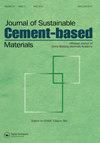稻壳灰碱活化剂对地聚合物砂浆常温养护的保鲜、力学和微观结构性能的影响
IF 4.2
3区 工程技术
Q1 CONSTRUCTION & BUILDING TECHNOLOGY
Journal of Sustainable Cement-Based Materials
Pub Date : 2023-10-12
DOI:10.1080/21650373.2023.2262465
引用次数: 0
摘要
摘要与硅酸盐水泥基混凝土(PC)相比,传统地聚合物被证明是环保的。然而,所使用的碱活化剂,即硅酸钠,与高碳排放和成本相关,使得地聚合物不是真正可持续的PC替代品。本试验旨在了解稻壳灰(RHA)基碱活化剂在常温下合成粉煤灰-高炉渣(FA-GGBFS)基地聚合物中的应用潜力。采用三种不同浓度的氢氧化钠溶液(重量%),即20%,24%和27%,合成了一种基于rhaa的碱活化剂。用工业级硅酸钠溶液对地聚合物砂浆(GPM)与制备的rhaa基碱活化剂的效果进行了比较。对RHA和商业级碱活化剂FA-GGBFS GPM样品进行了新鲜、机械和微观结构研究。在养护28 d时,基于rhaa的最佳GPM的抗压强度为41 MPa,与用商品活化剂制成的对照样品接近;流动表试验也发现了类似的观察结果。微观结构研究(XRD和SEM)证实,用rhaa基碱活化剂制备的GPM与用工业级碱活化剂制备的GPM具有相似的微观结构。关键词:地聚合物碱活化材料;稻壳;替代碱活化剂;Das:概念化,形式分析,可视化,调查,写作-原稿准备,写作-审稿编辑,监督;N. Behera:调查,方法论,形式分析,写作-原稿准备;S.K. Patro:概念化、可视化、监督和写作——审查和编辑;S.M. Mustakim:资源、写作、评论和编辑;须田:形式分析、写作审查和编辑;N. Leklou:验证和写作——审查和编辑。作者感谢csir -印度布巴内斯瓦尔矿物与材料技术研究所对本研究的实验支持。作者还感谢印度奥里萨邦Burla Veer Surendra Sai理工大学土木工程系Manoj Nayak先生和Pradyumna Kumar Sahu先生在实验调查过程中的帮助。印度布巴内斯瓦尔的Grøn Tek混凝土研究公司也因在本研究过程中提供的支持而受到认可。披露声明作者未报告潜在的利益冲突。本文章由计算机程序翻译,如有差异,请以英文原文为准。
Effectiveness of rice husk ash-derived alkali activator in fresh, mechanical, and microstructure properties of geopolymer mortar at ambient temperature curing
AbstractConventional geopolymers are proven to be eco-friendly compared to Portland cement-based concrete (PC). However, the used alkali activator, i.e. sodium silicate is associated with high carbon emission and cost, making the geopolymers not really a sustainable alternative to PC. This experimental investigation was carried out to understand the potential of rice husk ash (RHA)-based alkali activator in the synthesis of fly ash-blast furnace slag (FA-GGBFS)-based geopolymers at ambient temperature. Three different concentrations of sodium hydroxide (by wt. %) solutions, i.e. 20%, 24%, and 27%, were used to synthesize an RHA-based alkali activator. A commercial-grade sodium silicate solution was used to compare the results of geopolymer mortars (GPM) with the prepared RHA-based alkali activator. Fresh, mechanical, and microstructural investigations were carried out for both the RHA and commercial-grade alkali activator-based FA-GGBFS GPM specimens. The compressive strength of RHA-based optimum GPM was found to be 41 MPa at 28 days of the curing period, which was close to the control sample made with the commercial activator; similar observations were found for the flow table test. Microstructural investigation (XRD and SEM) confirmed that the GPM prepared with the RHA-based alkali activator has a similar microstructure as the GPM with the commercial-grade alkali activator.Keywords: Geopolymeralkali-activated materialsrice husk ashalternative alkali activatormicrostructure and mechanical properties Authors’ contributionsS.K. Das: Conceptualization, Formal analysis, Visualization, Investigation, Writing—original draft preparation, Writing—review and editing, and Supervision; N. Behera: Investigation, Methodology, Formal analysis, Writing—original draft preparation; S.K. Patro: Conceptualization, Visualization, Supervision, and Writing—review and editing; S.M. Mustakim: Resources, Writing—review and editing; Y. Suda: Formal analysis, Writing—review and editing; N. Leklou: Validation and Writing—review and editing.AcknowledgmentsThe authors acknowledge the experimental support of CSIR-Institute of Minerals and Materials Technology, Bhubaneswar, India, for this research. The authors also thank Mr. Manoj Nayak and Mr. Pradyumna Kumar Sahu of the Department of Civil Engineering, Veer Surendra Sai University of Technology, Burla, Odisha, India, for their help during the experimental investigation. Grøn Tek Concrete and Research, Bhubaneswar, India, is also acknowledged for the support provided during this research.Disclosure statementNo potential conflict of interest was reported by the authors.
求助全文
通过发布文献求助,成功后即可免费获取论文全文。
去求助
来源期刊
CiteScore
6.60
自引率
15.90%
发文量
71
期刊介绍:
The Journal of Sustainable Cement-Based Materials aims to publish theoretical and applied researches on materials, products and structures that incorporate cement. The journal is a forum for discussion of research on manufacture, hydration and performance of cement-based materials; novel experimental techniques; the latest analytical and modelling methods; the examination and the diagnosis of real cement and concrete structures; and the potential for improved cement-based materials. The journal welcomes original research papers, major reviews, rapid communications and selected conference papers. The Journal of Sustainable Cement-Based Materials covers a wide range of topics within its subject category, including but are not limited to: • raw materials and manufacture of cement • mixing, rheology and hydration • admixtures • structural characteristics and performance of cement-based materials • characterisation techniques and modeling • use of fibre in cement based-materials • degradation and repair of cement-based materials • novel testing techniques and applications • waste management

 求助内容:
求助内容: 应助结果提醒方式:
应助结果提醒方式:


